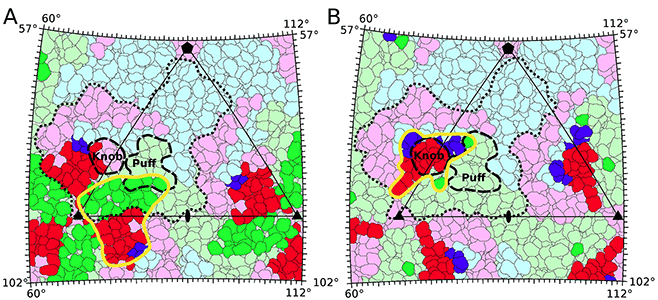Findings point to potential treatment for virus causing childhood illnesses
01-30-2014

Researchers have discovered a potential treatment for a viral infection that causes potentially fatal brain swelling and paralysis in children. The findings also point to possible treatments for related viruses including those that cause "common cold" symptoms.
The virus, called enterovirus 71 (EV71), causes yearly outbreaks of hand, foot, and mouth disease in Southeast Asian countries including China and Malaysia. Some of the infected children develop encephalitis that can be fatal or result in permanent brain damage. There are no anti-EV71therapeutic agents available.
The researchers prepared antibodies by immunizing mice with immature EV71 particles. Antibodies generated by this immunization induced a change in the mature EV71 virus, rendering it non-infectious by causing the virus particles to lose their genome.
The findings reveal a potential treatment mechanism, demonstrating that the antibody, called E18, has potential as an anti-EV71 therapy, said Michael G. Rossmann, Purdue's Hanley Distinguished Professor of Biological Sciences.
Findings are being reported this week in Proceedings of the National Academy of Sciences. The paper was authored by Purdue postdoctoral research associate Pavel Plevka; Pei-Yin Lim, a researcher from Sentinext Therapeutics in Penang, Malaysia; Purdue research scientist Rushika Perera; Jane Cardosa, a researcher at Sentinext and MAB Explorations in Malaysia; Purdue graduate student Ampa Suksatu; Richard J. Kuhn, a professor and head of Purdue's Department of Biological Sciences; and Rossmann.
EV71 belongs to a family of viruses called picornaviruses, pathogens that cause diseases including common-cold-like illnesses and poliomyelitis in people and chronic infections in livestock.
"The antibody-mediated virus neutralization by the induction of genome release has not been previously demonstrated," Rossmann said. "These results indicate that antibodies with genome-release activity could also be produced for other picornaviruses by immunization with immature particles. The approach could be used to prepare antibodies with similar properties against related viruses that include significant human pathogens."
Researchers observed and documented the loss of genome using two laboratory techniques: cryoelectron microscopy and a fluorescent SYBR Green dye assay.
Hand, foot and mouth disease, an infection most common among young children, sometimes arises in a daycare setting. Of the 427,278 cases of the disease recorded in China between January and May 2010, 5,454 cases were classified as severe, with 260 deaths, according to the World Health Organization.
The research has been funded by the National Institutes of Health.
Writer: Emil Venere, 765-494-4709, venere@purdue.edu
Sources: Pavel Plevka, 765-494-8712, plevka@purdue.edu
Michael Rossmann, 765-494-4911, mr@purdue.edu
Richard J. Kuhn, 765-494-4407, kuhnr@purdue.edu
Rushika Perera, perera@purdue.edu
Note to Journalists: A copy of the research paper is available by contacting Emil Venere, 765-494-4709, venere@purdue.edu
ABSTRACT
PNA Neutralizing antibodies can initiate genome release from human enterovirus 71
Pavel Plevka1, Pei-YinLim2, RushikaPerera1, JaneCardosa2,3, AmpaSuksatu1, Richard J. Kuhn1, and Michael G. Rossmann1
1 Department of Biological Sciences, Purdue University, West Lafayette, IN47907; 2 Sentinext Therapeutics, 10050Penang, Malaysia; and 3 MAB Explorations, 10050Penang, Malaysia
Antibodies were prepared by immunizing mice with empty, immature particles of human enterovirus71 (EV71), a picornavirus that causes severe neurological disease in young children. The capsid structure of these empty particles is different from that of the mature virus and is similar to "A" particles encountered when picornaviruses recognize a potential host cell before genome release. The monoclonal antibody E18, generated by this immunization, induced a conformational change when incubated at temperatures between 4°C and 37°C with mature virus, transforming infectious virions into A particles. The resultant loss of genome that was observed by cryo-EM and a fluorescent SYBR Green dye assay inactivated the virus, establishing the mechanism by which the virus is inactivated and demonstrating that the E18 antibody has potential as an anti-EV71 therapy. The antibody-mediated virus neutralization by the induction of genome release has not been previously demonstrated. Furthermore, the present results indicate that antibodies with genome-release activity could also be produced for other picornaviruses by immunization with immature particles.
Original article published in Purdue Today January 30, 2014.